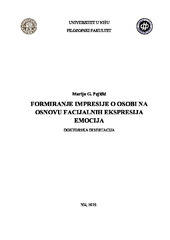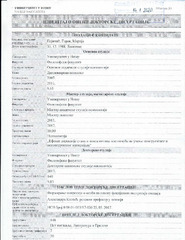| dc.contributor.advisor | Kostić, Aleksandra | |
| dc.contributor.other | Popadić, Dragan | |
| dc.contributor.other | Nešić, Vladimir | |
| dc.contributor.other | Komlenić, Miroslav | |
| dc.creator | Pejičić, Marija | |
| dc.date.accessioned | 2021-03-23T10:02:56Z | |
| dc.date.available | 2021-03-23T10:02:56Z | |
| dc.date.issued | 2020-09-25 | |
| dc.identifier.uri | http://eteze.ni.ac.rs/application/showtheses?thesesId=7865 | |
| dc.identifier.uri | https://fedorani.ni.ac.rs/fedora/get/o:1676/bdef:Content/download | |
| dc.identifier.uri | http://vbs.rs/scripts/cobiss?command=DISPLAY&base=70052&RID=22999049 | |
| dc.identifier.uri | https://nardus.mpn.gov.rs/handle/123456789/18154 | |
| dc.description | The aim of this research was examining the readiness of people to create an impression about an individual by relying on his/her facial
expressions of six primary emotions (happiness, sadness, fear, disgust, surprise and anger). Besides this, the role of the observed
individual’s gender and the observer's need for a cognitive closure in
this process were also examined. The sample consisted of the students
(N = 434) of both genders, from 18–25 years of age. In the first part
of this research, 334 respondents had the assignment to rank the
stimulus individuals’ faces on the Revised Interpersonal Adjective Scales and to fill in the self-evaluation questionnaire – the Need for Closure Scale. In the second part of the research, 100 respondents evaluated the attractiveness of the stimulus individuals’ faces and
filled in the Beliefs about men’s and women’s emotional behaviour
scale.
The results have shown that the observers are ready to draw
conclusions about individual’s general interpersonal tendencies based
on his/her current emotional reaction. The most dominant individuals were the ones on whose faces respondents recognised anger, then
happiness and disgust, next was surprise, then fear, and, in the end,
sadness. The highest average value on Affiliation was given to
individuals on whose faces the observers recognised happiness. It was
followed by sadness, fear and surprise, while disgust and anger were
in the end. The respondents saw men as more dominant and less
affiliative than women during the manifestation of all emotions, except anger, for which there were no differences on both Dominance
and Affiliation, and disgust, on Affiliation. With the increase of the
need for cognitive closure in observers, the number of adjectives which were ascribed to an individual on whose face there was fear were reduced. Also, with the increase in this need, there was growth of the number of extreme values on the Revised Interpersonal
Adjectives Scales and the tendency to evaluate the stimulus individuals on whose faces they recognised fear as less dominant and less affiliative, and individuals with the observed signs of anger as
more dominant.
The obtained results were interpreted within the context of the
communicative theory of emotions, by the content of gender
stereotypes which was acquired through socialisation within a certain
culture, and finally, by relying on the cognitive style of individuals
with a highly expressed need, which depends on their preferences of certainty, predictability and structure. | en |
| dc.format | application/pdf | |
| dc.language | sr | |
| dc.publisher | Универзитет у Нишу, Филозофски факултет | sr |
| dc.relation | info:eu-repo/grantAgreement/MESTD/Basic Research (BR or ON)/179002/RS// | |
| dc.rights | openAccess | en |
| dc.rights.uri | https://creativecommons.org/licenses/by-nc/4.0/ | |
| dc.source | Универзитет у Нишу | sr |
| dc.subject | emocija | sr |
| dc.subject | emotion | en |
| dc.subject | facijalna ekspresija | sr |
| dc.subject | impresija | sr |
| dc.subject | Dominacija | sr |
| dc.subject | Afilijativnost | sr |
| dc.subject | potreba za kognitivnom zatvorenošću | sr |
| dc.subject | facial expression | en |
| dc.subject | impression | en |
| dc.subject | Dominance | en |
| dc.subject | Affiliation | en |
| dc.subject | need for cognitive closure | en |
| dc.title | Formiranje impresije o osobi na osnovu facijalnih ekspresija emocija | sr |
| dc.type | PhD thesis | |
| dc.rights.license | BY-NC | |
| dcterms.abstract | Костић, Aлександра; Нешић, Владимир; Комленић, Мирослав; Попадић, Драган; Пејичић, Марија; Формирање импресије о особи на основу фацијалних експресија емоција; Формирање импресије о особи на основу фацијалних експресија емоција; | |
| dc.identifier.fulltext | https://nardus.mpn.gov.rs/bitstream/id/70380/Pejicic_Marija_G.pdf | |
| dc.identifier.fulltext | https://nardus.mpn.gov.rs/bitstream/id/70379/Disertacija.pdf | |
| dc.identifier.rcub | https://hdl.handle.net/21.15107/rcub_nardus_18154 | |



